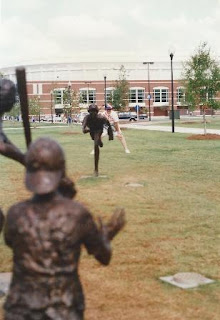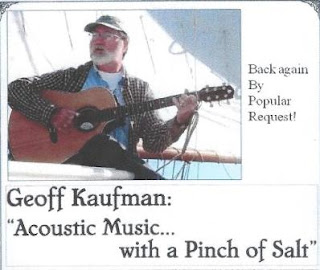Maine Native American History—
Today's Population
This is the final of the
three-part series about our Maine Native Americans. In this part we will
explore today’s populations; reference materials; and the Indian Land Claims
Settlement Act of 1980.
Recently, reader Janet
Bennett, led me to sites featuring Maine Native basket weaving. There was an
exhibit at the University of Maine, called “Transcending Traditions,” featuring
several Indian basket weavers who learned their craft at Indiantownship which
is downeast in Princeton. The site features several weavers. This picture is
one of those made by Eric “Otter” Bacon, a Passamaquoddy. For a look at these
beautiful baskets, go to
When I set up
housekeeping again in a real house, one of these baskets will be one of the
first things I buy. Remember when they used to have stands during the summer? I
think that was up Lincolnville way. We also had Indian moccasins available at a
store which I think was somewhere on Park Street. Don’t know if these were
machine-made or not, but I always coveted a pair. The old LL Bean had them too.
If you’d like to learn
more about Maine’s Native Americans, here are some places and events you could
check out while you are touring in Maine.
On August 12, 13, and
14, the members of the Passamaquoddy tribe in Perry will be celebrating the
“Revival of Indian Ceremonial Days,” at the Pleasant Point Reservation and the
general public is welcome.
The Sipayik Museum at
Pleasant Point Indian Reservation in Perry has many treasures to view. In
several rooms of the museum there are mannequins modeled after actual residents
of the Reservation. Some of these figures have been displayed at the Maine
State Museum in Augusta. There is a room set up where David Francis, Sr.
teaches the new written language. Here you will find many reference materials.
The Wabanakis shared
their artistry and history in Bar Harbor on July 7. Unfortunately this report
was not done by then. They have a Facebook page if you’d like to put it in your
favorite places for next year:
The Wabanakis dance at the Festival
Census
I couldn’t find too much
as to the population of our Native American population today, but here’s what I
did find. At the Penobscot reservation in Old Town, the 2000 census showed 562
residents. The Passamaquoddy Indian reservation in Perry has a population of
549. There were Indians in Hope too, but in 2000 their number was only 0.23%.
In 1822 there were 379 Passamaquoddy Indians; today there are more than 2,000.
Hope
Indians
Here’s a little back
history to share from the Hope Historical Society. I didn’t have this
information for the last blog.
Hope’s most historical
event was a war in 1615-17 between the East Penobscot Bay Tarratines and the
Pemaquid Wawenocks. Their peace treaty is said to have been signed at Hatchet Mountain
in Hope Corner. However, the Indian population of Hope at best was only 10 in
winter, when they camped and hunted for deer and bear; and zero in summer when they
left for the shore to get fish and shellfish.
Indian
Warfare
Warfare in Maine between
Indians and settlers lasted for 85 years more or less. It consisted of six
“Indian Wars.” These wars resulted in over 1,000 Maine settles being killed and
hundreds captured.
Before the Revolution
and before Maine became a separate state, treaties were made between each of
the two remaining tribes and the Commonwealth of Massachusetts which
established the Penobscots and Passamaquoddies as “nations” within the state. The
treaties gave the Penobscot Indians land on Indian Island in Old Town; the
Passamaquoddies at Pleasant Point in Eastport and Princeton; and guaranteed the
annual delivery of specified items of arms, cloth and food.
When Maine became a
state in 1820, it became guardian for the Penobscot and Passamaquoddy Tribes
and assumed responsibility for fulfilling these treaties.
Which leads us to the
next phase of Indian life in Maine:
The
Indian Land Claims Settlement Act of 1980
This act gave the two
tribes some hope of independence. The settlement included $81.5 million, with
some set aside in trust and some funds for land acquisition.
Here is a portion of
that act:
Sec.
1721. Congressional findings and declaration of policy
(a)
Findings and declarations
Congress
hereby finds and declares that:
(1)
The Passamaquoddy Tribe, the Penobscot Nation, and the
Maliseet
Tribe are asserting claims for possession of lands within
the
State of Maine and for damages on the ground that the lands in
question
were originally transferred in violation of law, including,
but
without limitation, the Trade and Intercourse Act of 1790 (1
Stat.
137), or subsequent reenactments or versions thereof.
(2) The Indians, Indian nations, and tribes and bands of
Indians, other than the Passamaquoddy Tribe, the
Penobscot Nation,
and the Houlton Band of Maliseet Indians, that once may
have held
aboriginal title to lands within the State of Maine long
ago
abandoned their aboriginal holdings.
(3) The Penobscot Nation, as represented as of the time
of
passage of this subchapter by the Penobscot Nation's
Governor and
Council, is the sole successor in interest to the
aboriginal entity
generally known as the Penobscot Nation which years ago
claimed
aboriginal title to certain lands in the State of Maine.
(4) The Passamaquoddy Tribe, as represented as of the
time of
passage of this subchapter by the Joint Tribal Council of
the
Passamaquoddy Tribe, is the sole successor in interest to
the
aboriginal entity generally known as the Passamaquoddy
Tribe which
years ago claimed aboriginal title to certain lands in
the State of
Maine.
(5) The Houlton Band of Maliseet Indians, as represented
as of
the time of passage of this subchapter by the Houlton
Band Council,
is the sole successor in interest, as to lands within the
United
States, to the aboriginal entity generally known as the
Maliseet
Tribe which years ago claimed aboriginal title to certain
lands in
the State of Maine.
(6) Substantial economic and social hardship to a large
number
of landowners, citizens, and communities in the State of
Maine, and
therefore to the economy of the State of Maine as a
whole, will
result if the aforementioned claims are not resolved
promptly.
(7) This subchapter represents a good faith effort on the
part
of Congress to provide the Passamaquoddy Tribe, the
Penobscot
Nation, and the Houlton Band of Maliseet Indians with a
fair and
just settlement of their land claims. In the absence of
congressional action, these land claims would be pursued
through the
courts, a process which in all likelihood would consume
many years
and thereby promote hostility and uncertainty in the
State of Maine
to the ultimate detriment of the Passamaquoddy Tribe, the
Penobscot
Nation, the Houlton Band of Maliseet Indians, their
members, and all
other citizens of the State of Maine.
(8) The State of Maine, with the agreement of the
Passamaquoddy
Tribe and the Penobscot Nation, has enacted legislation
defining the
relationship between the Passamaquoddy Tribe, the
Penobscot Nation,
and their members, and the State of Maine.
(9) Since 1820, the State of Maine has provided special
services
to the Indians residing within its borders, including the
members of
the Passamaquoddy Tribe, the Penobscot Nation, and the
Houlton Band
of Maliseet Indians. During this same period, the United
States
provided few special services to the respective tribe,
nation, or
band, and repeatedly denied that it had jurisdiction over
or
responsibility for the said tribe, nation, and band. In
view of this
provision of special services by the State of Maine,
requiring
substantial expenditures by the State of Maine and made
by the State
of Maine without being required to do so by Federal law,
it is the
intent of Congress that the State of Maine not be
required further
to contribute directly to this claims settlement.
(b) Purposes
It is the purpose of this subchapter--
(1) to remove the cloud on the titles to land in the
State of
Maine resulting from Indian claims;
(2) to clarify the status of other land and natural
resources in
the State of Maine;
(3) to ratify the Maine Implementing Act, which defines
the
relationship between the State of Maine and the
Passamaquoddy Tribe,
and the Penobscot Nation, and
(4) to confirm that all other Indians, Indian nations and
tribes
and bands of Indians now or hereafter existing or
recognized in the
State of Maine are and shall be subject to all laws of
the State of
Maine, as provided
herein.
The right to establish
casinos in Maine by the Indians was excluded. Indians did, however, buy the
Cement Plant in Thomaston as an investment. They didn’t actually work at the
plant.
At the Pleasant Point
Indian Reservation in Perry, the Settlement made it possible to build new
homes, an administration center, and a recreational building. Stores and
industry have also been created.
After all these
generations of being treated as non-residents of their own land, they finally
have something to smile about.
The fourth Friday in
September became “Native American Day” when President Ronald Reagan signed a
resolution establishing it. It became a state holiday in California in 1998.
As this third portion of
“Maine Native American History” has run long, I will include all the references
I found in a separate blog, “Maine Native American History References.” Look
for materials for children here also.
Thanks for listening.




























